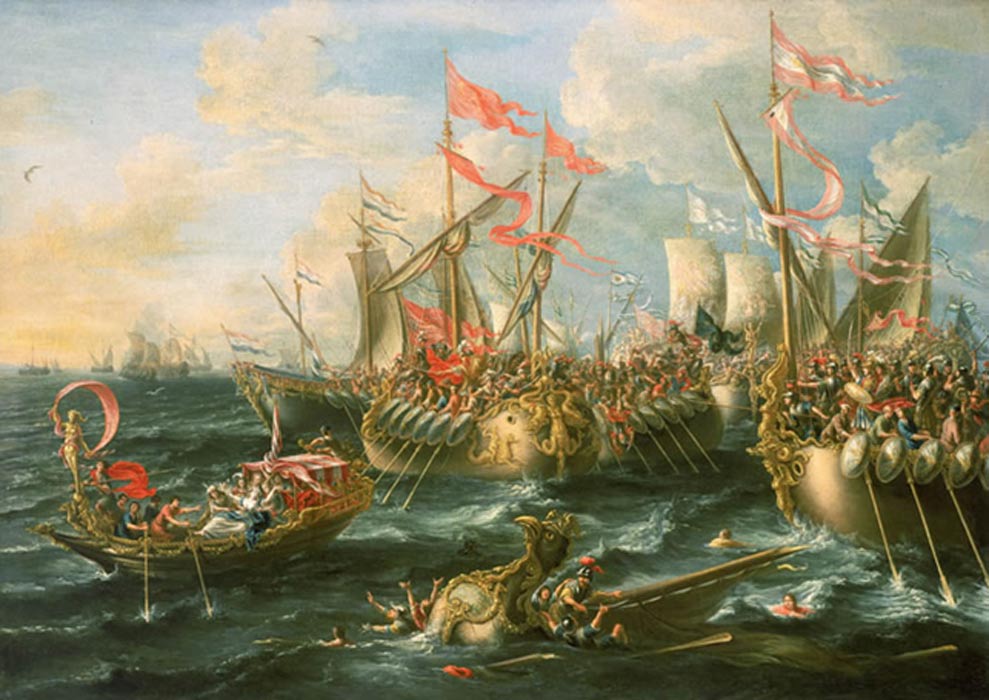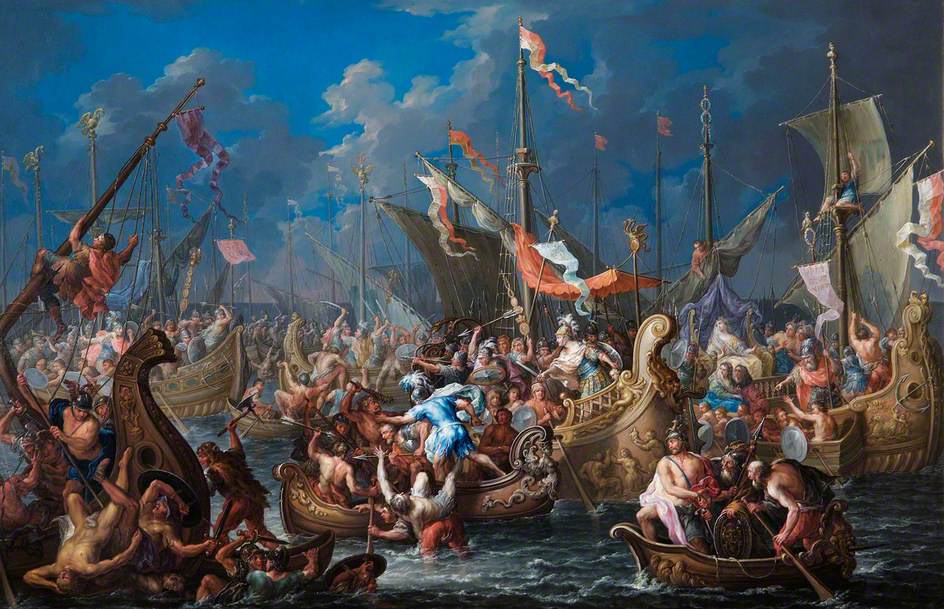By Edward Whelan, Contributing Writer, Classical Wisdom
The battle of Actium was one of the most important naval battles in all of history. The victory resulted in the fall of Mark Anthony and Cleopatra and the elevation of Augustus to the position of absolute ruler of the Roman Empire. Indeed, this battle determined the direction and the fate of the Roman Empire for over five centuries.
The Background to the Battle of Actium
Rome was engulfed by civil war for decades and was fought over by a series of generals, such as Marius, Sulla, Pompey, and Julius Caesar. Following the assassination of Caesar (49 BC), a political alliance known as the Second Triumvirate brought a measure of stability between his heir Octavian, Mark Anthony, and Lepidus. The Roman world and spheres of influence were divided between Octavian and Mark Anthony. The heir of Caesar controlled the Roman West and Anthony the East. Cleopatra, the ruler of Egypt, became the lover of Mark Anthony and so the two effectively ruled the Eastern Mediterranean.

‘The Battle of Actium, 2 September 31 BC’ (1672) By Laureys a Castro
A war between Octavian and Mark Anthony became inevitable when Caesar’s adopted son side-lined Lepidus, contrary to an earlier agreement. Many in Rome suspected that Mark Anthony wanted to rule the East as a separate state but nonetheless a significant party in Rome supported Anthony, as they were anxious about the ambitions of Octavian. The spark that caused the final war of the Roman Republic was Mark Anthony’s divorce of Octavia, the sister of Octavian.
Prelude to Battle of Actium
Mark Anthony moved quickly; he assembled a huge navy at Ephesus (modern Turkey) and also moved a large army into the Balkans. Many of these ships were sent by Cleopatra who later joined her partner. Anthony knew that speed was essential. He sailed his armada to the Ionian Sea and his ships found harbor in Actium, a rocky promontory. With his fleet sheltered in the bay and a large land army also assembled at Actium (now Preveza, Greece), Mark Anthony was preparing to invade Italy and to march on Rome.

Coin of Anthony and Cleopatra
Meanwhile, Octavian skillfully won support in Rome by portraying Anthony as the pawn of Cleopatra. Octavian appointed his friend Agrippa to the position of admiral to his fleet. He was a brilliant strategist and had gathered his ships in the Ionian Sea. He then attempted to blockade Cleopatra and Octavia at Actium, which made Cleopatra and her Egyptian contingent nervous; they wanted to sail back to Alexandria. Octavian learned of this and was going to let Mark Anthony and his Egyptian Queen escape, however, Agrippa urged him to attack. This forced Mark Anthony to give battle.
The Sea Battle of Actium
The two fleets met outside the Gulf of Actium on a still and beautiful morning on the 2nd of September, 31 BC. Cleopatra and her partner had over 300 ships, many of which were massive galleys complete with towers, full of archers and marines. Octavian, on the other hand, had about 250 warships, which were often smaller. Many were galleys, known as Liburnians, that had long been used by Illyrian pirates and were well suited to the waters of the Ionian Sea. Anthony’s ships had more men and were larger, but they were slow and cumbersome. One of Anthony’s general defected to the enemy and told Octavian of his battle plans. Moreover, there was a disagreement between Anthony’s and Cleopatra’s contingents.

A Liburnian galley- from the 1st century AD
When the battle commenced Agrippa cleverly used the ballista and other missile weapons on his ships. He would launch hit and run attacks against the smaller vessels. Eventually, Anthony was forced to leave the protection of Actium Bay and sought to engage with Octavian’s fleet. This led to an all-day battle. During the fighting, the ships were used rather like platforms from which archers and marines fought each other. They would often board the enemy ships and engage in brutal hand to hand combat.
Sometimes ballistae would sink a ship, but this was not common. Many more were set on fire during the fighting by flaming projectiles. Most of the larger galleys were equipped with rams (rostra) and ships would ram into other vessels to damage or sink them. Agrippa had invented a grappling hook that was fired from a ballista, which allowed ships to be boarded more effectively and gave Octavian’s fleet a real advantage. Thousands were killed or drowned as the battle raged.
There are two main theories as to how the Battle of Actium developed. Many argue that Anthony was winning the battle at this stage, however, the Egyptian contingent, apparently under orders, decided to sail for Alexandria. It had not really taken part in the battle. When the Egyptians began to sail away, it caused Anthony to panic and this led to the loss of many ships. There are others who argue that Anthony was defeated in the sea battle and he fought a rear-guard action to allow his beloved Cleopatra to escape to her kingdom.
Whatever the reason, by the evening of the 2nd of September, Mark Antony’s navy was in full retreat. Octavian did not follow him as he was saving sailors and soldiers from sinking ships and the sea. The following day the heir of Julius Caesar seized the camp of Anthony and the majority of his enemy’s army surrendered to him without a fight.
The Aftermath of the Battle of Actium

The Death of Cleopatra by Reginald Arthur, 1892. (Public Domain).
Mark Anthony and Cleopatra made it safely back to Egypt. Cleopatra tried to sign a separate peace with Octavian, but he refused; he wanted to parade her in his Triumph. Anthony and Cleopatra’s allies began to abandon them and soon they realized that their position was hopeless. Mark Anthony and Cleopatra both committed suicide rather than be taken alive.
Octavian became the first Roman Emperor. His victory at Actium was the death-knell of the Roman Republic.
References
Lange, C. H. (2011). The battle of Actium: a reconsideration. The classical quarterly, 61(2), 608-623.











No comments yet. You should be kind and add one!
Our apologies, you must be logged in to post a comment.